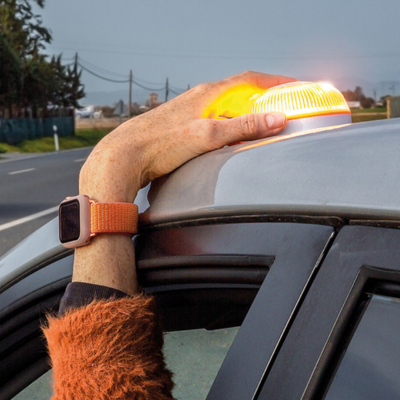Spain’s Directorate-General for Traffic (DGT) has announced that from 1 January 2026, all vehicles on Spanish roads must be equipped with a V-16 emergency beacon, replacing the traditional warning triangles used to signal breakdowns or accidents. This regulation aims to enhance road safety by reducing the risk to drivers and passengers when their vehicles are immobilised.
Why is the V-16 beacon being introduced?
The V-16 beacon is a small, flashing light that is placed on the roof of a vehicle in the event of an emergency. Unlike warning triangles, which require drivers to exit their vehicles—posing a significant risk on motorways and high-speed roads—the V-16 beacon can be deployed without leaving the car, significantly improving safety, particularly in poor visibility or hazardous locations.
These beacons emit a 360-degree amber flashing light that can be seen from a considerable distance, helping to alert other road users to a stranded vehicle well in advance.
Additional safety features: Geolocation technology
To further enhance safety, all DGT-approved V-16 beacons will be fitted with geolocation technology. When activated, the device sends the vehicle’s exact location to the DGT’s traffic management system in real-time. This allows emergency services and roadside assistance to respond more efficiently, reducing delays and improving accident prevention measures.
The geolocation data will be transmitted via Spain’s cloud-based DGT 3.0 traffic system, ensuring accurate and up-to-date information for authorities and other road users.
Implementation timeline and penalties
- Until 31 December 2025: Both traditional warning triangles and V-16 beacons can be used.
- From 1 January 2026, the use of the V-16 beacon will become mandatory, and warning triangles will no longer be accepted as a legal alternative.
- Penalties: Drivers who fail to comply with the regulation could face fines of €80 to €200.
Preparing for the change
V-16 beacons are already available on the market, but not all models meet DGT’s approved specifications. Drivers are advised to purchase a certified beacon to ensure compliance before the 2026 deadline. They should also familiarise themselves with the device’s operation to use it quickly and effectively in an emergency.
A Step Forward in Road Safety
This initiative reflects Spain’s commitment to adopting modern technology to improve road safety. By replacing traditional warning triangles with high-visibility, geolocated emergency beacons, the new regulation aims to reduce roadside fatalities and provide quicker response times for stranded motorists.
Drivers travelling in Spain—whether residents or visitors—should take note of this upcoming rule change and prepare accordingly to enhance their safety and ensure compliance with the law.
Country
Geographical coverage
